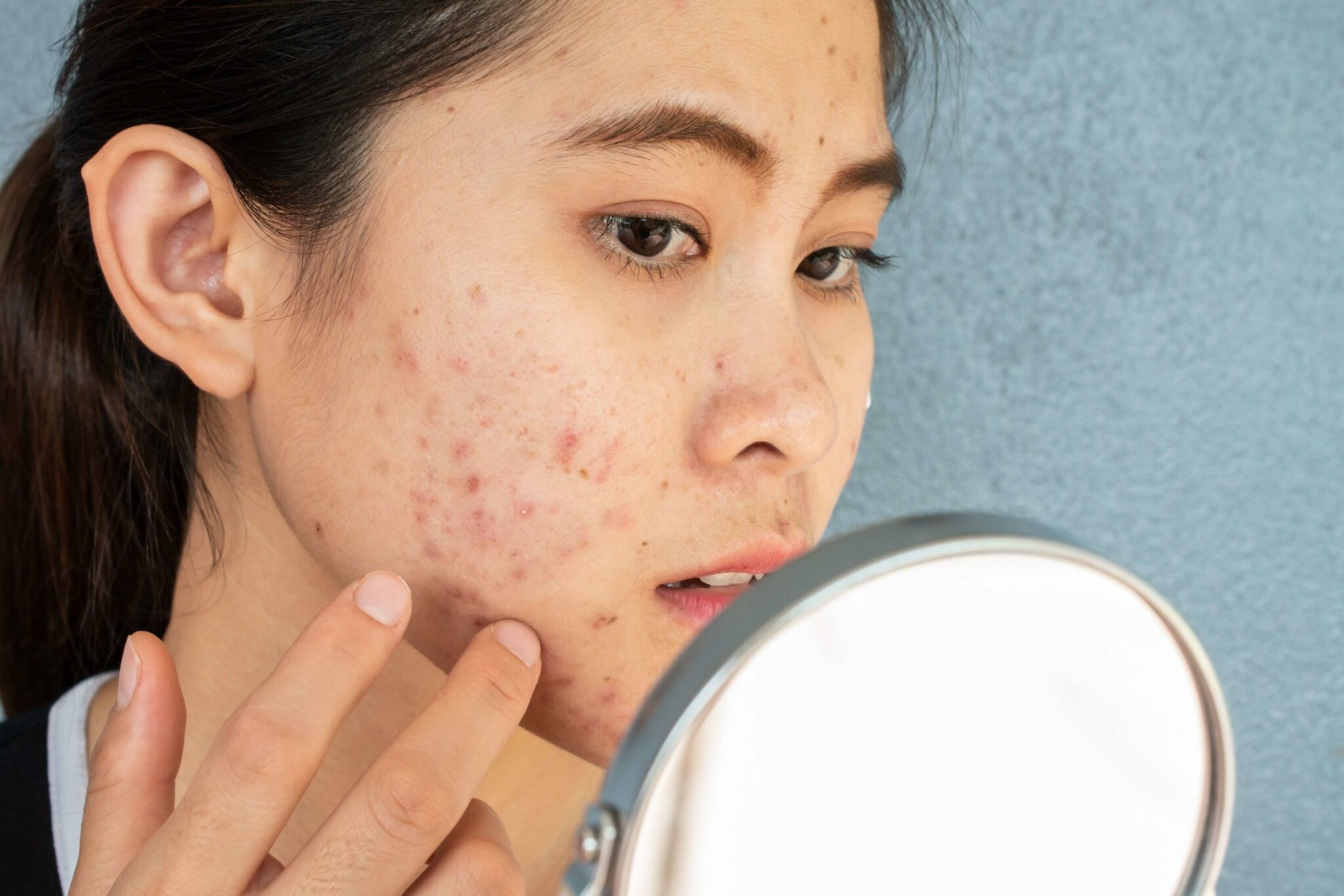Why do I get Acne Breakouts Before my Period?

Puberty is hard work. Not only do those in the midst of it have to manage fluctuating mood swings, but there are often unwanted physical manifestations to deal with as well. One of the most distressing of these can be acne. Highly prevalent amongst adolescents, acne vulgaris is a skin condition that causes discomfort and reduced self-confidence from the time it first appears. With time, many of the most unwanted symptoms of puberty disappear, but acne can be something that continues to bother people well beyond their pubertal years. Women can be particularly prone to acne breakouts in the days before their period.
It is important to note, however, that acne is not a condition restricted to females; it affects both males and females and is probably exacerbated by a range of triggers, including genes, hormones and the environment. The multifactorial aetiology of the condition is what makes it a challenge to treat and probably explains why recurrence rates are high.
Although the exact prevalence of post-adolescent acne is unknown, many women experience skin breakouts in the days before their period starts. This article aims to address the question of what causes increased acne in the run up to menstruation. We will also attempt to identify whether there are any positive associations between increased acne susceptibility and other endocrine disorders.
What is acne?
The sebaceous glands are present in the skin. They are involved in the synthesis of several hormones, although their primary function appears to be the excretion of sebum. Sebum is an oily substance, rich in lipids, wax esters and fatty acids, along with smaller amounts of cholesterol. The detrimental consequences of too much sebum are well understood, with an excess of it contributing to oily skin and acne. However, the normal physiological role is less well established. Originally thought to be of limited importance and a vestigial trait from the time of our ancestors; researchers now believe sebum is involved in maintaining the integrity of the skin’s barrier.
Acne is thought to occur when there is extensive formation of sebum, which accumulates and blocks the sebaceous glands. The debris that collects provides an ideal growth medium for Propionibacterium acnes, which triggers an exaggerated inflammatory reaction and the formation of the pustules, papules and pimples that are characteristic of an acne breakout. Evidence for the role of sebum in acne breakouts comes from the fact that drugs which cause sebaceous gland atrophy (isotretinoin) are effective at treating severe cases of acne.
The link between acne and the menstrual cycle
The fact that so many women experience an acne breakout just before their period, suggests a strong hormonal link. The skin is known to contain receptors for the predominant female sex hormones, oestrogen and progesterone; as well as the androgens, testosterone and dihydrotestosterone. Androgens in particular are thought to increase the sensitivity of the sebaceous glands and trigger more sebum production. Support for this theory comes from the fact that during puberty there is a surge in circulating androgens, which often coincides with the development of teenage acne. Furthermore, drugs that inhibit the production of androgens are one of the treatment options for acne.
Oestrogen is also thought to be involved in mitigating sebaceous gland activity. High doses of oestrogen reduce sebaceous gland secretions. It is suggested that midway through the ovulatory cycle, the sebaceous glands become more active, leading to seborrhoea (excessive sebum secretion) and mild acne. This coincides with the time in the cycle at which oestrogen levels fall after ovulation, in the time leading up to the start of menstruation. In fact, drugs such as the oral contraceptive pill, which contains a synthetic oestrogen, are an alternative treatment option for those with severe acne.
The involvement of other hormones
Insulin stimulates the growth and maturation of the sebaceous glands. It also contributes to increased androgen production. It is a widely held belief that a poor diet contributes to acne. This is controversial and there is little evidence for direct dietary involvement in acne formation; however, foods with a high glycaemic index increase insulin levels, which stimulates the production of androgens. An excess of androgens, as described above, increases sebum secretions and seems to trigger acne breakouts. Thus, indirectly, a poor diet could worsen the condition of acne-prone skin.
Other hormones are also implicated in the pathogenesis of acne, including corticotropin-releasing hormone, melanocortins, glucocorticoids and pituitary hormones. Most of these hormones act in feedback loops, either stimulating sebum secretion or contributing to the synthesis of the androgens.
Polycystic Ovary Syndrome (PCOS) and acne
PCOS accounts for more than 90% of cases of hyperandrogenism (excessive androgens) in females. Women with PCOS are also very likely to be insulin resistant and have hyperinsulinaemia (high levels of circulating insulin). As such, acne is a common symptom of PCOS.
Endometriosis is common, but not well understood. One study found that girls who had severe teenage acne had a 20% higher risk of developing endometriosis. The reasons for this remain unknown, although both conditions are thought to have an inflammatory component. In both conditions the immune response is inefficient. There may also be hormonal involvement, although the evidence for this is currently limited.
Coping with adult acne
Acne can be a very difficult condition to live with. People who suffer from regular flare ups may find it affects their confidence and their quality of life. If you are experiencing regular acne breakouts around the time of your period and it is making your life miserable, you should consult a specialist dermatologist. They will be able to advise you on your treatment options, which may include hormone therapy, antibiotics, retinoids or isotretinoin (only used in severe cases, due to significant adverse side effects). Non-drug options include photodynamic therapy and chemical peels. However, these require further work to optimise the specific details, including effective dose and peel constituents. They are also unlikely to provide permanent relief from hormonally-driven acne.
Try our acne pack, it will help with your skin glow and it will look healthier.
Nabta is reshaping women’s healthcare. We support women with their personal health journeys, from everyday wellbeing to the uniquely female experiences of fertility, pregnancy, and menopause.
Get in touch if you have any questions about this article or any aspect of women’s health. We’re here for you.
Sources:
- “Acne: Treatment.” NHS Choices, NHS, https://www.nhs.uk/conditions/acne/treatment/.
- Elsaie, Mohamed. “Hormonal Treatment of Acne Vulgaris: an Update.” Clinical, Cosmetic and Investigational Dermatology, vol. 9, 2 Sept. 2016, pp. 241–248., doi:10.2147/ccid.s114830.
- Geller, L, et al. “Perimenstrual Flare of Adult Acne.” The Journal of Clinical and Aesthetic Dermatology, vol. 7, no. 8, Aug. 2014, pp. 30–34.
- Hermanns-Lê, Trinh, et al. “Cyclic Catamenial Dermatoses.” BioMed Research International, vol. 2013, 2013, pp. 1–5., doi:10.1155/2013/156459.
- Xie, J., et al. “Severe Teenage Acne and Risk of Endometriosis.” Human Reproduction, vol. 29, no. 11, Nov. 2014, pp. 2592–2599., doi:10.1093/humrep/deu207.
- Zouboulis, Christos C., et al. “Frontiers in Sebaceous Gland Biology and Pathology.” Experimental Dermatology, vol. 17, no. 6, June 2008, pp. 542–551., doi:10.1111/j.1600-0625.2008.00725.x.










